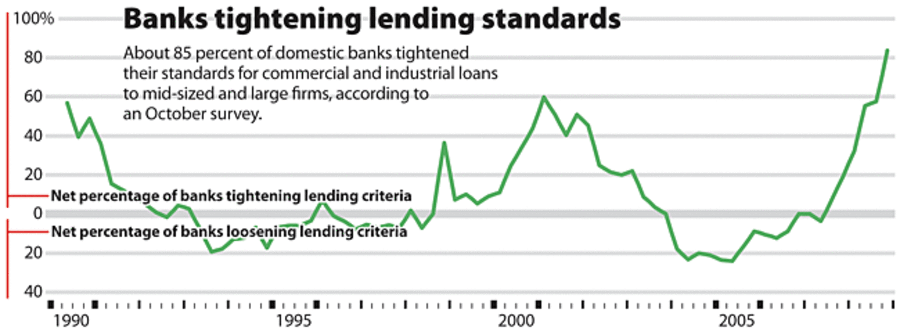Credit crunch shows little sign of easing
In the aftermath of a historic lending boom, a key challenge for America in 2009 is to find the right footing on debt – allowing the credit bubble to deflate while not depriving the economy of needed fuel.
Seeking the right balance is a difficult test for policymakers, since the economy has downshifted sharply since September.
To some extent, a tightening of credit simply reflects the reality of cooler economic times. But economists generally say the credit markets also face an abnormal squeeze now – one that justifies many of the extraordinary actions that the Federal Reserve and Treasury have taken in recent months. The latest example came last week, as the Treasury Department decided to rescue GMAC to prevent a freeze-up in the auto-loan market.
"We were obviously at one extreme a couple of years ago. Credit was too easy," says Nariman Behravesh, chief economist at IHS Global Insight in Lexington, Mass. Now "the pendulum swung way over in the other direction."
He says the credit crunch is serious, with many consumers and businesses unable to get financing that would usually be available.
"Borrowers are still having a hard time," Mr. Behravesh says. Without a healthier flow of credit, it will be hard for the economy to stage a solid recovery from recession.
At the same time, it's not just the availability of credit that has shrunk. It's also demand for new loans.
Some forecasters say that what's occurring is an unavoidable "deleveraging," or reduction of debt, by both households and corporations.
The US has experienced a two-decade expansion of credit availability – punctuated in recent years by phenomena such as mortgage loans with no down payment, says David Rosenberg, an economist at the investment bank Merrill Lynch in New York. "Attitudes toward spending and debt have changed semipermanently," he argues in a recent report to clients.
After a year in which $12 trillion in stock and real estate asset wealth were wiped off household ledgers, he says families will be focused not on borrowing but on boosting their annual saving back up to about 5 percent of income.
In this environment, some economists have made the case that the very term "credit crunch" is misleading.
Consumer credit, including credit-card debt, has risen over the past year, not fallen, for example. The volume of mortgage debt has shrunk, but so has the volume of home sales and the value of homes.
The total of bank loans outstanding to corporations hasn't shown any big plunge.
Researchers at the Federal Reserve Bank of Minneapolis pushed this view in a report published in October, titled "Facts and Myths About the Financial Crisis of 2008." But their peers at the Federal Reserve Bank of Boston came back with a rebuttal paper.
People who keep close tabs on conditions for raising capital and credit say the reality is mixed.
At a recent meeting of corporate financial officers near Boston, sponsored by the Massachusetts Institute of Technology's Sloan School of Management, the mood was sober but not panicked.
Conditions are tight and may take at least a year to come back to normal, the finance officers said. But firms and individuals with strong creditworthiness can raise money.
"It's not impossible," says Mark Shooman, an accountant who advises entrepreneurial companies in the Boston area. But "it's difficult for companies to find funding right now."
Still, he says some pullback in lending is appropriate.
"It shouldn't be really easy to get funding," Mr. Shooman says.
The Internet bubble in the late 1990s and the housing bubble in this decade are examples of what can go wrong when lending is too easy.
One of the big ideas for reviving the economy now is for more government intervention to bring down mortgage interest rates and encourage more home loans.
The Fed, with the goal of greasing the wheels for home loans, plans to launch purchases of mortgage securities backed by Fannie Mae and Freddie Mac this month.
But some critics of this idea say the government should let housing prices find their own equilibrium – and not try to perpetuate inflated prices.
Since September, the Fed has also increasingly become a direct lender to industrial firms, in effect, by buying corporate debts called commercial paper. Economists generally applaud this move, saying it is keeping the credit crunch from being much worse.
Tight credit conditions constrain the ability of corporations to create new jobs. It's that, as well as a shift in business sentiment and the direct effects of a slowdown in consumer spending, that may be pushing the unemployment rate higher.
The Fed's quarterly survey of bank loan officers also finds evidence of a crunch. The percentage of banks tightening the terms of credit is at much higher levels today than in the past two recessions (see chart below).
Many consumers are tapping their existing credit lines, but it's harder to get new ones.






